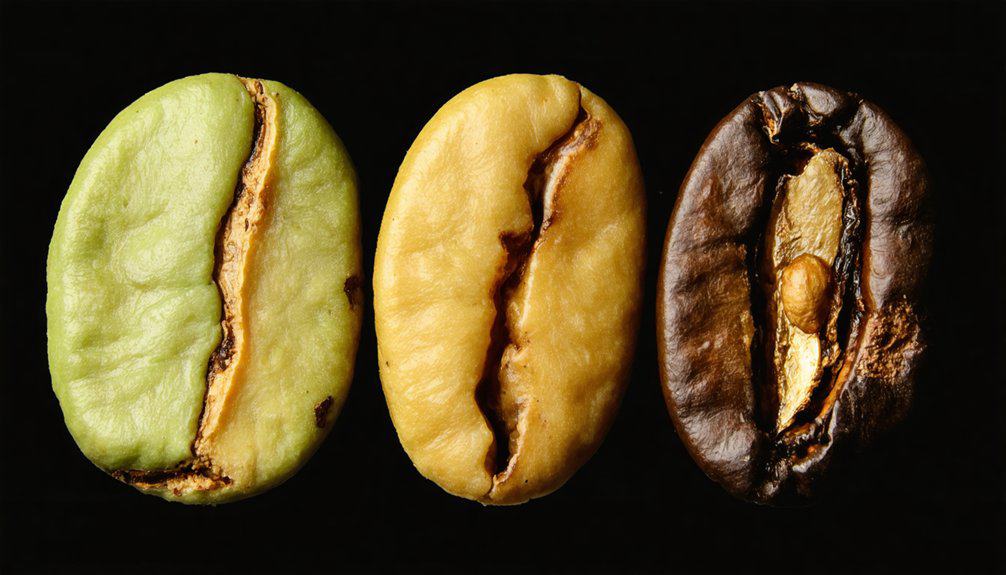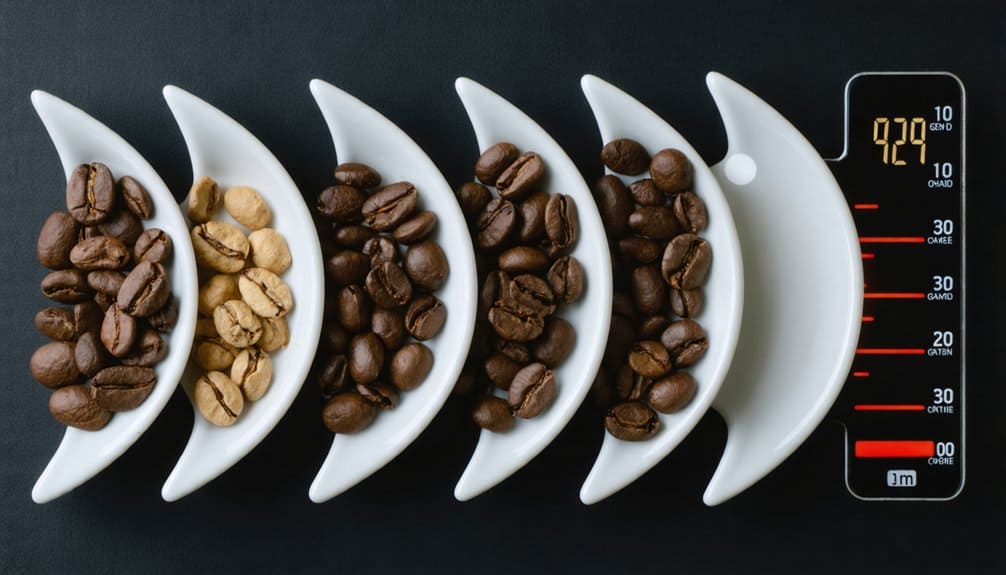You’ll need to manage distinct temperature phases when roasting coffee, starting with the drying phase at 160°C, progressing through the Maillard reaction, and reaching initial crack around 196-202°C.
For light roasts, aim for 180-205°C with 6-9 minutes total time; medium roasts require 210-219°C for 7-11 minutes; dark roasts need 225-245°C for 12-15 minutes.
Understanding these precise temperature and time relationships opens your ability to control flavor development.
Key Takeaways
- Light roasts require 6-9 minutes at 180-205°C, preserving original coffee characteristics and producing high acidity profiles.
- Medium roasts achieve optimal flavor development between 210-219°C over 7-11 minutes, creating balanced sweetness.
- Coffee undergoes first crack at 196-202°C, marking a crucial transition point between light and medium roasts.
- Dark roasts need 12-15 minutes at 225-245°C, with second crack occurring around 224-226°C for bittersweet flavors.
- Begin with 4-8 minutes drying phase at 160°C, followed by Maillard reaction phase, then post-crack development.
Understanding Coffee Roast Profiles and Development Stages

When crafting the perfect coffee roast, understanding roast profiles serves as the foundation for achieving consistent, high-quality results.
You’ll need to master three critical development stages: the drying phase (4-8 minutes at up to 160°C), the Maillard reaction, and the post-initial crack development.
For optimal flavor development, you must prevent baked coffee taste by maintaining steady temperature progression.
Your success depends on carefully balancing key parameters like total roast time and bean temperature while accounting for variables such as bean origin, processing method, and hardness.
You’ll know you’re progressing through the stages as you observe moisture removal, color changes, and that distinctive initial crack sound signaling the start of development.
Essential Temperature Ranges for Different Roast Levels
To achieve precise control over coffee roast levels, you’ll need to master specific temperature ranges that define each roasting stage.
Light roasts develop at 180-205°C, reaching primary crack around 200°C, while medium roasts require 210-219°C for ideal development.
When you’re aiming for medium-dark profiles, target 225°C, just before second crack begins.
Dark roasts demand temperatures between 230-245°C, with second crack occurring around 224-226°C.
Understanding these critical temperature points allows you to consistently hit your desired roast profile and connect with the precise flavor characteristics your customers expect.
Lighter roasts retain more of the coffee’s original characteristics than darker roasts.
Critical Time Markers in the Roasting Process

The precise timing of each roasting phase plays an essential role in achieving consistent, high-quality results.
You’ll observe the initial green-to-yellow shift within 4-8 minutes at 300-330F, marking the start of Maillard reactions.
The vital Maillard phase follows for 4-6 minutes at 330-390F, where you’ll develop core flavor compounds.
Skilled operators rely on 13 data sensors to maintain optimal temperature control throughout the process.
First crack emerges around 6-7 minutes at 390-400F, signaling the change to development phase.
You’ll need to carefully manage the development time ratio through this stage. Post-first crack, you’ve got 1-3 minutes before cooling, depending on your target roast level.
First and Second Crack: Temperature Milestones
Preliminary and second crack serve as critical audible and temperature milestones in coffee roasting, signaling distinct chemical and physical transformations within the beans.
You’ll encounter preliminary crack at 196-202°C, marking the lighter roast threshold.
It’s preceded by the “A” point (177°C), where volatile oils release initial coffee aromas. As moisture evaporates, beans expand considerably.
Many roasters aim to achieve most balanced flavor between these two cracks.
Second crack occurs at 224-226°C, initiating darker roast territories.
The bean structure breaks down, revealing surface oils and developing bittersweet, caramel notes.
You’ll notice diminished acidity beyond this point.
Understanding these temperature markers is vital for achieving consistency and precision in your roasting profiles.
Mastering Roast Times for Light to Dark Profiles

Mastering roast times across different profiles demands precise control over temperature progression and development phases.
You’ll need to adjust your approach based on your target roast level and bean characteristics.
| Roast Level | Time Range | Primary Crack | Temperature | Key Characteristics |
|---|---|---|---|---|
| Light | 6-9 min | Early | 196-205°C | High acidity, clarity |
| Medium | 7-11 min | Mid | 210-219°C | Balanced, sweet |
| Dark | 12-15 min | Late | 225-245°C | Bittersweet, oily |
| Very Dark | 15+ min | Post-2nd | >245°C | Heavy body |
| City+ | 10-12 min | Extended | 215-225°C | Full development |
For light roasts, you’ll want to maintain higher initial temperatures with dense beans, while dark roasts require careful heat management to avoid scorching.
Monitor your development time ratios to achieve ideal flavor extraction.
Cooling beans rapidly to below 40°C within four minutes after roasting is essential for preserving the intended flavor profile.
FAQs
How Does Altitude Affect Coffee Roasting Temperatures and Times?
You’ll need higher temperatures and longer roasting times at increased altitudes, as decreased atmospheric pressure and humidity reduce heat transfer efficiency. Lower altitudes require reduced temperatures due to denser air.
Can Different Power Sources Impact the Consistency of Coffee Roasting?
Like a conductor leading an orchestra, your power source matters. Electric roasters offer better consistency with automated controls, while gas roasters need more vigilance but both can achieve repeatable results.
What Causes Uneven Roasting Within the Same Batch of Beans?
You’ll find uneven roasting stems from temperature inequality in your roasting drum, inadequate drum rotation (below 6 RPM), poor airflow distribution, and variations in thermal diffusivity across your bean mass.
How Do Seasonal Temperature Changes Affect Home Coffee Roasting?
You’ll need to adjust roast settings as seasons change. In winter, start with higher temperatures and longer roast times. Monitor humidity levels and preheat your beans for consistent results year-round.
Should Roasting Temperatures Be Adjusted for Different Coffee Bean Sizes?
You’ll need to adjust temperatures for bean size variations, as larger beans require higher heat for proper development, while smaller beans need lower temperatures to prevent scorching and guarantee even roasting.
The Bottom Line
Your roasting repertoire requires precise parameters and practiced patience.
By mastering meaningful temperature milestones and timing shifts, you’ll consistently create engaging coffee profiles.
Whether you’re pursuing perfectly light, medium, or dark development stages, keep in mind that roasting’s remarkable results depend on your detailed data tracking and deliberate decisions.
Monitor your metrics, master your machine’s momentum, and maintain meticulous measurements for ideal outcomes.
